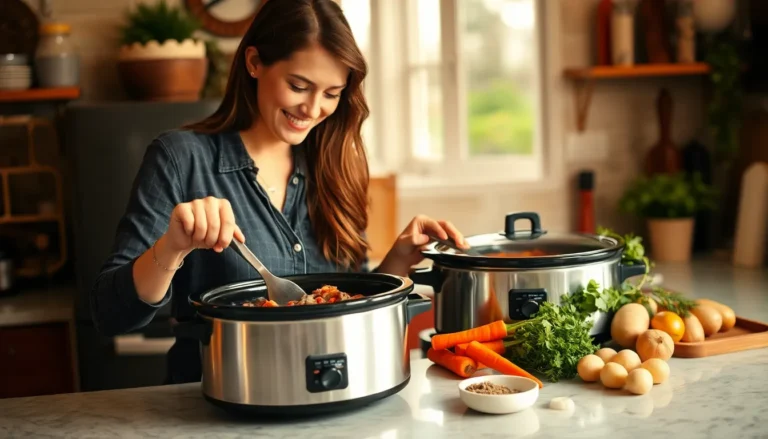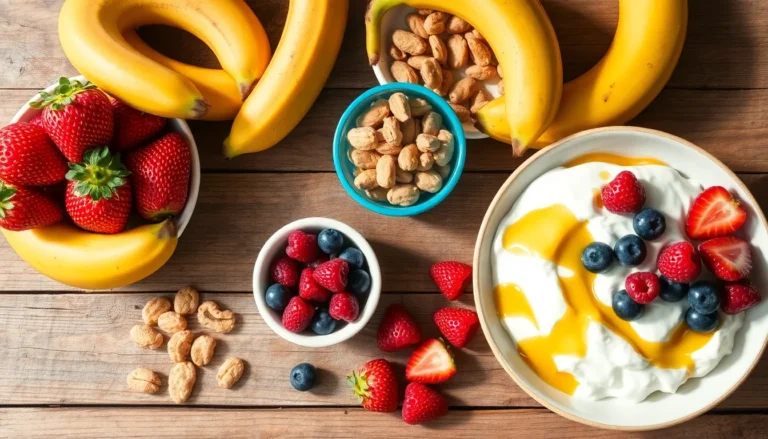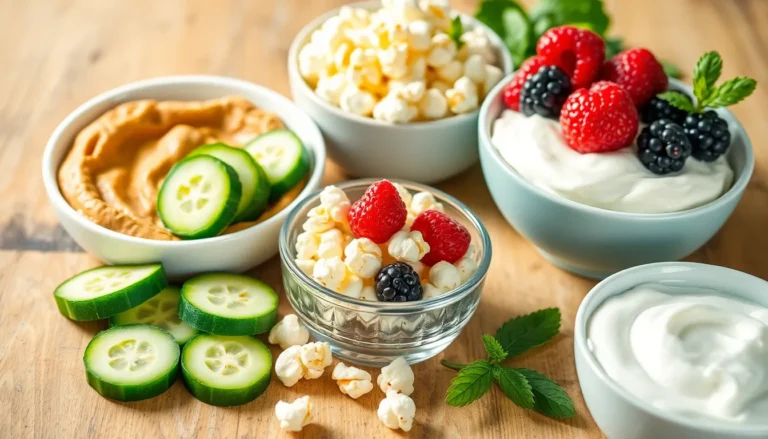Table of Contents
ToggleSauces can turn a mundane meal into a culinary masterpiece. Whether it’s a drizzle of zesty chimichurri over grilled veggies or a creamy Alfredo coating a mountain of pasta, the right sauce can elevate any dish from “meh” to “wow.” Imagine your taste buds dancing with joy as they experience flavors that make every bite an adventure.
Classic Sauce Recipes
Classic sauces form the backbone of many culinary traditions. These recipes are simple yet versatile, enhancing various dishes.
Marinara Sauce
Marinara sauce stands as a staple in Italian cuisine. This sauce combines tomatoes, garlic, onion, and herbs, offering a rich flavor. To prepare, sauté minced garlic and onion in olive oil. Next, add crushed tomatoes and season with basil and oregano. Simmer for 30 minutes, allowing flavors to meld. Marinara pairs well with pasta, meatballs, and as a pizza sauce. Storing marinara sauce in the refrigerator enhances its taste for up to one week, making it a practical option for meal prep.
Béchamel Sauce
Béchamel sauce serves as the base for many creamy dishes. Making béchamel involves a simple process of whisking together milk, butter, and flour. Start by melting butter in a saucepan, then stir in equal parts flour to form a roux. Gradually whisk in milk, continuing until the mixture thickens. Season with salt and a pinch of nutmeg for added flavor. Béchamel works beautifully in lasagna, macaroni and cheese, and as a roux for creamy soups. This sauce can last for several days in the refrigerator, making it useful for quick meal preparations.
International Sauce Varieties

Sauces around the world each bring unique flavors to dishes, reflecting their culinary traditions. Varieties include rich Italian sauces and vibrant Asian sauces.
Italian Sauces
Tomato-based sauces like marinara and arrabbiata are staples of Italian cuisine. Marinara combines tomatoes with garlic, herbs, and onions, perfect for pasta. Arrabbiata packs a spicy punch, featuring garlic, tomatoes, and chili peppers. Pesto sauce, made from basil, garlic, pine nuts, and olive oil, offers a fresh, herby alternative. These sauces complement dishes ranging from pizza to meatballs.
Asian Sauces
Soy sauce serves as a foundational element in many Asian dishes, known for its savory, umami flavor. Combining soy sauce with garlic, ginger, and sesame oil creates a delicious stir-fry sauce. Sweet and sour sauce blends sugar, vinegar, and fruit juices, enhancing dishes like sweet and sour chicken. Hoisin sauce brings depth with its mix of soy and spices, commonly used in Asian barbecue. These sauces elevate flavors in stir-fries, dumplings, and rice dishes.
Unique and Modern Sauce Creations
Sauces continue to evolve, reflecting modern culinary trends. These unique and innovative sauces provide fresh options for diverse dishes.
Avocado Sauce
Creamy avocado sauce adds richness to any meal. This sauce blends ripe avocados with lime juice, garlic, and cilantro for a vibrant flavor. Ideal for tacos, salads, or grilled vegetables, it also enhances the taste of fish and chicken dishes. Preparing this sauce takes only a few minutes. Use a blender for a smooth and consistent texture. Stored in an airtight container, it remains fresh for up to two days, maintaining its bright color and flavor.
Peanut Sauce
Peanut sauce delivers a delightful balance of sweet and savory. Combining peanut butter, soy sauce, garlic, and ginger creates a versatile dressing or dipping sauce. Great for stir-fries, noodle dishes, or as a salad dressing, it offers a unique taste profile. Crafting this sauce requires minimal effort. A whisk or blender can ensure a smooth consistency. When refrigerated, this sauce lasts up to one week, making it perfect for meal prep.
Tips for Perfecting Sauce Techniques
Sauce techniques greatly enhance the creation of delicious flavors. Attention to detail in preparation and storage ensures optimal enjoyment.
Balancing Flavors
Achieving a harmonious flavor profile remains crucial in sauce preparation. Start with anchoring flavors, such as acidity from vinegar or citrus. Layering sweetness, spice, and umami can create depth. For example, adding honey to a vinaigrette balances acidity. Consider seasoning gradually, tasting as ingredients combine for precision. Fresh herbs or spices can elevate sauces, providing brightness. Remember that different cultures emphasize unique flavor combinations, showcasing the versatility of sauces.
Proper Storage Methods
Proper storage methods sustain sauce freshness and flavor integrity. Utilize airtight containers for optimal preservation in the refrigerator. For sauces containing dairy, consuming them within three to five days maintains quality. Freezing certain sauces extends their shelf life for up to three months. Thawing sauces in the refrigerator overnight, rather than at room temperature, prevents bacterial growth. Labeling containers with preparation dates helps track freshness efficiently. Understanding proper storage ensures sauces remain delicious and ready for culinary use.
Sauces are essential in the culinary world, transforming simple dishes into memorable meals. With a variety of classic and modern recipes at one’s fingertips, home cooks can explore endless flavor combinations. Whether it’s a rich béchamel or a zesty chimichurri, each sauce offers a unique twist that enhances the dining experience.
Embracing diverse sauce techniques and flavors from around the globe can elevate everyday cooking. By mastering these recipes and tips, anyone can create delicious meals that impress family and friends. Sauces not only enrich meals but also inspire creativity in the kitchen, making them a vital component of any culinary repertoire.






